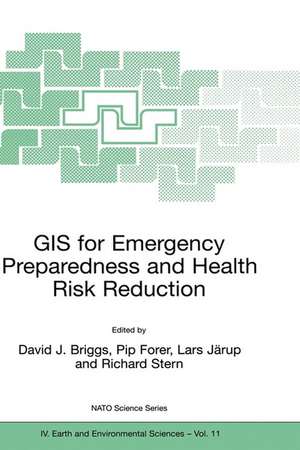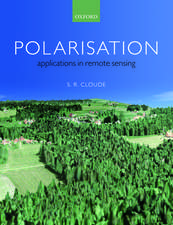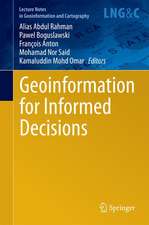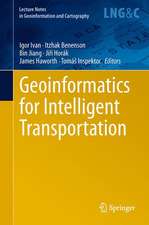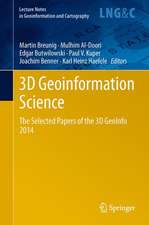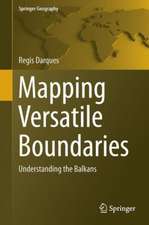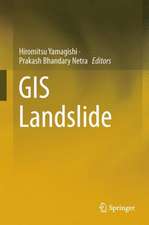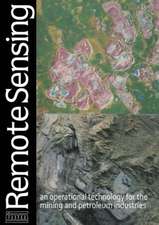GIS for Emergency Preparedness and Health Risk Reduction: NATO Science Series: IV:, cartea 11
Editat de David J. Briggs, Pip Forer, Lars Järup, Richard Sternen Limba Engleză Hardback – 31 aug 2002
The important matters discussed here include the probabilistic nature of most environmental hazards and the semi-random factors that influence interactions between these and human exposures; the effects of temporal and spatial scales on hazard assessment and imputed risk; the effects of measurement error in risk estimation and the stratification of risks and their impacts according to socioeconomic characteristics; and the quantification of socioeconomic differences in vulnerability and susceptibility to environmental hazards.
| Toate formatele și edițiile | Preț | Express |
|---|---|---|
| Paperback (1) | 948.79 lei 6-8 săpt. | |
| SPRINGER NETHERLANDS – 31 aug 2002 | 948.79 lei 6-8 săpt. | |
| Hardback (1) | 953.65 lei 6-8 săpt. | |
| SPRINGER NETHERLANDS – 31 aug 2002 | 953.65 lei 6-8 săpt. |
Din seria NATO Science Series: IV:
- 18%
 Preț: 1225.94 lei
Preț: 1225.94 lei - 15%
 Preț: 640.06 lei
Preț: 640.06 lei - 18%
 Preț: 950.84 lei
Preț: 950.84 lei - 18%
 Preț: 950.96 lei
Preț: 950.96 lei - 18%
 Preț: 948.61 lei
Preț: 948.61 lei - 18%
 Preț: 945.92 lei
Preț: 945.92 lei - 15%
 Preț: 644.63 lei
Preț: 644.63 lei - 18%
 Preț: 945.92 lei
Preț: 945.92 lei -
 Preț: 402.56 lei
Preț: 402.56 lei - 18%
 Preț: 1229.91 lei
Preț: 1229.91 lei - 15%
 Preț: 646.43 lei
Preț: 646.43 lei - 15%
 Preț: 647.08 lei
Preț: 647.08 lei -
 Preț: 394.51 lei
Preț: 394.51 lei - 18%
 Preț: 1230.21 lei
Preț: 1230.21 lei - 15%
 Preț: 657.57 lei
Preț: 657.57 lei - 18%
 Preț: 1835.83 lei
Preț: 1835.83 lei - 18%
 Preț: 1825.12 lei
Preț: 1825.12 lei - 18%
 Preț: 958.73 lei
Preț: 958.73 lei - 18%
 Preț: 951.29 lei
Preț: 951.29 lei - 18%
 Preț: 944.51 lei
Preț: 944.51 lei - 18%
 Preț: 1015.55 lei
Preț: 1015.55 lei - 15%
 Preț: 647.08 lei
Preț: 647.08 lei - 18%
 Preț: 1827.80 lei
Preț: 1827.80 lei - 18%
 Preț: 1835.53 lei
Preț: 1835.53 lei -
 Preț: 395.63 lei
Preț: 395.63 lei - 18%
 Preț: 944.99 lei
Preț: 944.99 lei
Preț: 953.65 lei
Preț vechi: 1162.99 lei
-18% Nou
Puncte Express: 1430
Preț estimativ în valută:
182.50€ • 198.17$ • 153.30£
182.50€ • 198.17$ • 153.30£
Carte tipărită la comandă
Livrare economică 22 aprilie-06 mai
Preluare comenzi: 021 569.72.76
Specificații
ISBN-13: 9781402007989
ISBN-10: 1402007981
Pagini: 326
Ilustrații: XIII, 326 p.
Dimensiuni: 155 x 235 x 25 mm
Greutate: 0.68 kg
Ediția:2002
Editura: SPRINGER NETHERLANDS
Colecția Springer
Seria NATO Science Series: IV:
Locul publicării:Dordrecht, Netherlands
ISBN-10: 1402007981
Pagini: 326
Ilustrații: XIII, 326 p.
Dimensiuni: 155 x 235 x 25 mm
Greutate: 0.68 kg
Ediția:2002
Editura: SPRINGER NETHERLANDS
Colecția Springer
Seria NATO Science Series: IV:
Locul publicării:Dordrecht, Netherlands
Public țintă
ResearchCuprins
One. GIS for emergency preparedness and health risk reduction: concepts and principles.- 1. Preparing for environmental health emergencies: the role of GIS.- 2. Timelines, environments and issues of risk in health: the practical algebra of (x,y,t,a).- 3 Social models of disaster: vulnerability and empowerment.- 4 Uncertainty in the application of GIS for predictive health risk assessment for a radioactive waste repository in Slovenia.- Two. GIS for emergency preparedness.- 5 Evaluation of volcanic fallout impact from Vesuvius using GIS.- 6 Volcanic risk assessment and spatial planning policies in the island of Hawai’i.- 7 The risk assessment of hazardous materials transportation using GIS.- 8 A GIS-aided frequency planning tool for terrestrial broadcasting and land mobile services.- 9 Progress towards harmonised European industrial risk management information systems.- 10 Application of the Seveso II Directive in Slovenia with the support of GIS.- Three. GIS for health risk reduction.- 11 A European health and environment information system for exposure and disease mapping and risk assessment (EUROHEIS).- 12 Address geocoding for small area environmental health studies in Denmark.- 13 Health characteristics of the Stockholm population - disease mapping using a computerised system.- 14 Small area statistics on health (SMASH): a system for rapid investigations of cancer in Finland.- 15 Geographical distribution of cardiovascular mortality in Comunidad Valenciana (Spain).- 16 Application of GIS for assessing the risk of water-borne diseases in the Samarkand Province.- 17 Geographical aspects of mortality and morbidity data in Hungary: a GIS analysis.- List of Workshop Participants.
